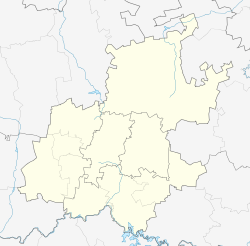
Johannesburg is the most populous city in South Africa with 4,803,262 people in the City of Johannesburg alone. It is a conurbation engulfing many formerly separate cities and towns and is classified as a megacity. It is one of the 100 largest urban areas in the world. It is the provincial capital of Gauteng, the wealthiest province in South Africa. Johannesburg is the seat of the Constitutional Court, the highest court in South Africa. Most of the major South African companies and banks have their head offices in Johannesburg. The city is located within the mineral-rich Witwatersrand hills, the epicentre of the international-scale mineral and gold trade.
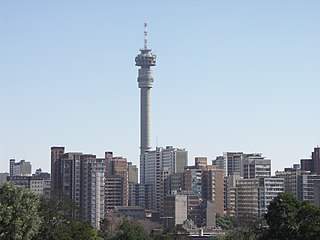
Hillbrow is an inner city residential neighbourhood of Johannesburg, Gauteng Province, South Africa. It is known for its high levels of population density, unemployment, poverty, prostitution and crime.

This article discusses Chinatowns in Africa. There are at least three major Chinatowns in Africa.

Johannesburg is a large city in Gauteng Province of South Africa. It was established as a small village controlled by a Health Committee in 1886 with the discovery of an outcrop of a gold reef on the farm Langlaagte. The population of the city grew rapidly, becoming a municipality in 1898. In 1928 it became a city making Johannesburg the largest city in South Africa. In 2002 it joined ten other municipalities to form the City of Johannesburg Metropolitan Municipality. Today, it is a centre for learning and entertainment for all of South Africa. It is also the capital city of Gauteng.
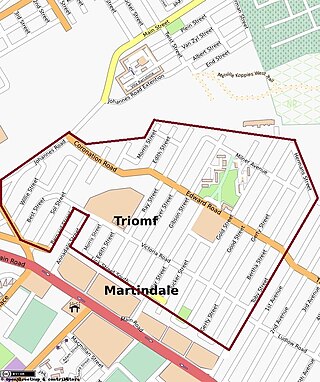
Sophiatown, also known as Sof'town or Kofifi, is a suburb of Johannesburg, South Africa. Sophiatown was a poor multi-racial area and a black cultural hub that was destroyed under apartheid. It produced some of South Africa's most famous writers, musicians, politicians and artists, like Father Huddleston, Can Themba, Bloke Modisane, Es'kia Mphahlele, Arthur Maimane, Todd Matshikiza, Nat Nakasa, Casey Motsisi, Dugmore Boetie, and Lewis Nkosi.

Roodepoort is a city in the Gauteng province of South Africa. Formerly an independent municipality, Roodepoort became part of the Johannesburg municipality in the late 1990s, along with Randburg and Sandton. Johannesburg's most famous botanical garden, Witwatersrand National Botanical Gardens, is located in Roodepoort.
Lenasia, also known as Lenz, is a suburb south of Soweto in the Gauteng province, South Africa, originally created to house Indians. It is located in Region G of the City of Johannesburg Metropolitan Municipality. Lenasia is approximately 35 kilometres southwest of the Johannesburg Central Business District.

The suburbs of Johannesburg are officially demarcated areas within the City of Johannesburg Metropolitan Municipality, South Africa. As in other Commonwealth countries, the term suburb refers to a "neighbourhood", although in South Africa most "suburbs" have legally recognised borders and often separate postal codes. The municipal functions for the area, such as municipal policing and social services, are still managed by the city government.
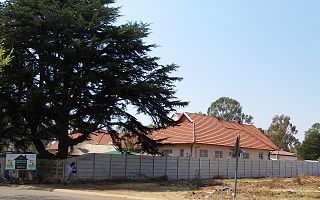
Brakpan is a mining town on the East Rand of Gauteng, South Africa, approximately 38 kilometres east of Johannesburg.
Yeoville is an inner city neighbourhood of Johannesburg, in the province of Gauteng, South Africa. It is located in Region F. Originally intended as a "well-to-do" neighbourhood, it instead developed into a white working class and lower middle class area as the city expanded northwards and public rail access improved. From the 1920s onwards it became a significant enclave of German Jewish and Eastern European Jewish immigrants. It was designated as a "white area" under the Group Areas Act during the apartheid era. It became a "grey area" in the 1980s, as a limited number of non-white residents began to rent in the area. From the end of the 1970s, a growing number of night clubs and galleries opened in Yeoville, or relocated from Hillbrow. This led to the neighbourhood becoming the leading nightspot in the city.The white population began to decline in the 1970s, and this white flight accelerated in the early to mid 1990s, with most residents migrating to the northern suburbs. Today, it is widely known and celebrated for its diverse, pan-African population but notorious for its high levels of crime, poverty and degradation.
Johannesburg North is a suburb of Randburg, South Africa. It is located in Region C of the City of Johannesburg Metropolitan Municipality.
Mayfair is a suburb of Johannesburg, South Africa. The suburb is west of the Johannesburg CBD and is adjacent to Fordsburg. It is located in Region F of the City of Johannesburg Metropolitan Municipality.
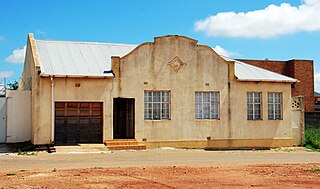
Pageview is a suburb of Johannesburg, South Africa. It is located in Region F of the City of Johannesburg Metropolitan Municipality. Populated by non-whites, predominantly Indians, until the 1970s, it was one of two adjacent suburbs commonly known as Fietas.
Randpark Ridge is an upmarket suburb of Randburg, South Africa. It is located in Region B of the City of Johannesburg. It fell into the town of Randburg during the apartheid era. Developed in the early 1980s and still relatively new, Randpark Ridge is bordered by several other suburbs including Weltevreden Park, Sundowner, Boskruin, Bromhof, Honeydew and Fairland.

The Rand Rebellion was an armed uprising of white miners in the Witwatersrand region of South Africa, in March 1922.

The Oriental Plaza, known locally as the Plaza is a large shopping centre and tourist attraction in Fordsburg, a suburb of Johannesburg, South Africa. Consisting of multiple connected malls, it was created for Indian traders who were forcibly removed from nearby Fietas by the apartheid government.
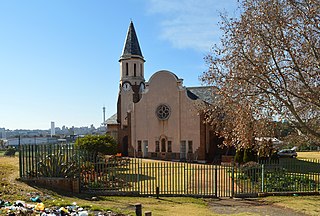
Vrededorp is a suburb of Johannesburg, South Africa. It is located in Region F of the City of Johannesburg Metropolitan Municipality. Vrededorp is situated on the North-Western side of Johannesburg and is 1,764 m (5,788 ft) above sea level.

Fordsburg Square in Fordsburg is a thriving square that is the site of a flea market was recently known for being run-down. This square in Johannesburg is the location of a battle between striking miners and the South African police, army and air force.
The Red Square was an open plaza in Fordsburg, South Africa that was a popular site for mass political meetings in the 1940s and 1950s. The site is now covered by the South Mall and Car Park 4 of the Oriental Plaza. Completed in 1976, the Plaza was built to accommodate Indian traders evicted by the apartheid government from the main trading street, 14th Street as well as other streets including the eastern and western boundary street, Delarey and Krause streets of Pageview, Fietas.
The Fordsburg Reformed Church was a congregation of the Dutch Reformed Church in South Africa (NGK) that served the western Johannesburg suburb of Fordsburg from November 6, 1896, to 1988.
